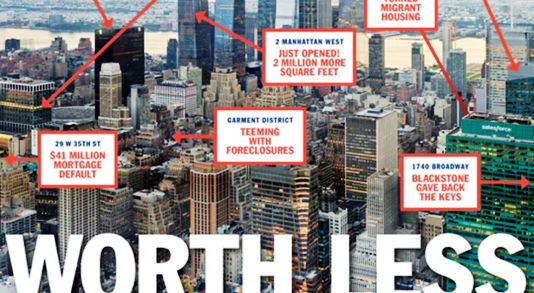There are many green shoots in today’s broad economic landscape. They’re encouraging, and we remain committed to trading this bull market higher.
But the way we protect our wealth is by paying more attention to weeds than green shoots. And if you’re looking for weeds today, just type “commercial real estate” into Google. Here are the headlines that populated results (all from within just the last few days):
– Commercial Property Investors’ Huge Office Bet is Unraveling in London, New York – Bloomberg
– Commercial real estate may not recover until 2024, with low-occupancy, high-cost cities like New York and San Francisco hit hardest – Fortune
– Record Miami Land Sales Collapses Amid Commercial Real-Estate Slowdown – Wall Street Journal
– The source of remote work sends U.S. office distress up to $24.8 billion – that’s even worse than malls and hotels – Fortune
– San Francisco Commercial Property Values May Fall 40% by 2025 – The San Francisco Standard
– Commercial Property Distress Hits $71B in Q2, Led By Office – Bisnow
Below is the July cover of New York Magazine. If you’re having trouble reading the slug line, it reads:
“Manhattan’s office buildings are dangerously empty and crushed by debt, and their owners are in over their heads.”

In a recent Digest, the “economic hurricane” headed our way was profiled. Namely, trillions of dollars of low-cost corporate debt are maturing over the next three years that will have to be refinanced at today’s significantly higher interest rates. This will cause enormous financial pain.
Legendary investor Warren Buffett once quipped, “You only find out who is swimming naked when the tide goes out.” Well, with the Fed nearly certain to raise rates to 5.25% – 5.50% on Wednesday and hold them there, and $1.4 trillion in commercial real estate debt coming due by the end of next year, the tide is going out. And no sector has more “naked swimmers” than commercial real estate.
Given this, regular Digest readers know that for months, we’ve been running a “commercial real estate watch” segment to monitor this critically important sector of the U.S. economy. The same factors that resulted in a handful of banking failures this spring are creating cracks in the foundation of the $20-trillion commercial real estate sector. If defaults snowball, it will have an enormous domino-effect on the U.S. economy.
The latest story for the “Watch” segment features billionaire real estate investor Barry Sternlicht. Though not the household name of say, Warren Buffett or Paul Tudor Jones, Sternlicht is a legend in his own right. He made a name for himself as a real estate bargain hunter who scooped up distressed assets during financial meltdowns (he was a buyer in the aftermath of the US savings and loan collapse, and later, in the Great Financial Crisis). He’s now the Chairman of Starwood Capital Group, which has $115 billion in assets under management.
If anyone has a pulse on the commercial real estate sector, it’s Sternlicht. As to that pulse, here’s his conclusion:
–We’re in a Category 5 hurricane.
–It’s sort of a blackout hovering over the entire industry until we get some relief or some understanding of what the Fed’s going to do over the longer term.
–Let’s jump to the Bloomberg article featuring an interview with Sternlicht:
–Financing now is more expensive and harder to come by. Landlords with floating-rate loans are facing the prospect of higher debt payments…
–In the meantime, tight credit conditions are complicating developers’ efforts to start projects or refinance existing buildings. In one recent example, Starwood reached out to 33 banks for a loan on a small property and received just two offers, Sternlicht said.
–Lenders are also reluctant to take possession of struggling assets. In one case where Starwood tried to surrender an office building, the lender instead offered to restructure the loan.
In explaining the problem facing his company and other real estate outfits, Sternlicht explains that Starwood’s loans feature interest-rate caps. But those caps will be expiring. And when they do, thanks to the Fed’s rate hikes, instead of paying 1% or 2%, they’ll be paying 8% of 9%.
Here’s his takeaway:
–Many assets won’t be able to cover debt service.
–And so, you’ll be having negotiations with your lenders. And you’ll have to rewrite these loans. And there’s going to be a serious credit contraction.
–While this is concerning for real estate investors, Sternlicht points toward a problem most investors are missing…
From Sternlicht:
–The country – in any asset class – has not adjusted to that cost of capital yet. But it’s coming.
–I find it fascinating and concerning that Sternlicht believes asset classes haven’t adjusted to the debt repricing that’s on the way – especially so for stocks.
Here’s the rest of Sternlicht’s related comment:
–The economy will slow. You can see the numbers. CEO confidence is down, consumer confidence is down, retail sales are down. The service economy is wickedly strong.
–It just feels like the last gasp before we actually settle into what should be — what you’d expect to be — I hope it’s a shallow recession. I hope he can pull that off.
–That would be quite an execution.
Keep in mind the daisy chain of real estate defaults, first for small banks, then for the broader economy
Here’s The Wall Street Journal highlighting the connection between commercial real estate and small banks:
–Smaller banks are crucial drivers of credit growth, the fuel that powers the economy.
–Banks smaller than the top 25 largest account for around 38% of all outstanding loans, according to Federal Reserve data.
–They account for 67% of commercial real estate lending.
Now, if real estate loans are on the verge of going belly up… and small banks are behind 67% of real estate lending… what might be the outcome?
Here’s Bloomberg:
–“You could see a second RTC,” Sternlicht said, referring to Resolution Trust Corp., the government entity charged with liquidating assets of the savings and loan associations that failed in the late 1980s and early 1990s.
–“You could see 400 or 500 banks that could fail,” he said. “And they will have to sell.”
Continuing our daisy chain, failing banks export their financial pain to the broader economy. That’s because surviving banks go into “circle the wagons” mode, ratcheting up their lending standards to protect their capital. This starves the economy of growth, resulting in economic stagnation.
But this is not all “doom and gloom” The flip side of economic crisis is opportunity. If you’re the holder of quality-yet-distressed assets bought at a high price who is being forced to sell at a low price, it’s a fortune-breaker. But if you’re an investor flush with cash, those same low prices are a fortune-maker.
This is exactly how Sternlicht made his real estate riches – buying quality properties at fire-sale prices during market upheavals. And true to form, Sternlicht is already looking ahead to real estate opportunities. He says that the sector refrain has become “survive ‘til ’25.”
But you don’t have to be a big-money real estate investor to follow Sternlicht’s gameplan. It works equally well for stock investors.
As highlighted in the Digest for months, today’s stock market is undeniably bullish. Let’s trade it higher for as long as we can. But a wise trading mindset is one that’s disciplined and will sell stocks once they hit stop-losses. This offers investors a powerful two-pronged benefit – capital preservation and investment funding.
Borrowing our own language from a moment ago and adapting it, if you’re the holder of distressed stocks bought at a high price who is being forced to sell at a low price, it’s a fortune-breaker. But if you’re an investor flush with cash, those same low stock prices are a fortune-maker. This is why we mind our stop-losses. One, they prevent irrecuperable losses; two, they free up capital that can be used to buy great assets as bargain prices.
Last Friday, Digest featured a quote from a research report titled “Who Chases Returns? – Retail vs. Institutional Investor Behavior”:
“For retail investors, returns-chasing behavior is a one-way street. said Jason Karceski, associate professor of finance, University of Florida, in an interview. “Retail Investors tend to let their underperforming investments sit.”
Don’t be that investor. Ride this bull market for everything it has, but if/when it turns, don’t let your underperforming investments sit. Don’t ride them all the way down.
Bottom line: It’s not known exactly what this commercial real estate “Category 5 hurricane” will mean for real estate, banks, the economy, and the stock market. Perhaps it will fizzle out and bring little more than a few thunderstorms before the sunshine returns. But by being disciplined, we can weather whatever comes, and be ready to capitalize on the blue-sky conditions that follow.
Source: MSN

